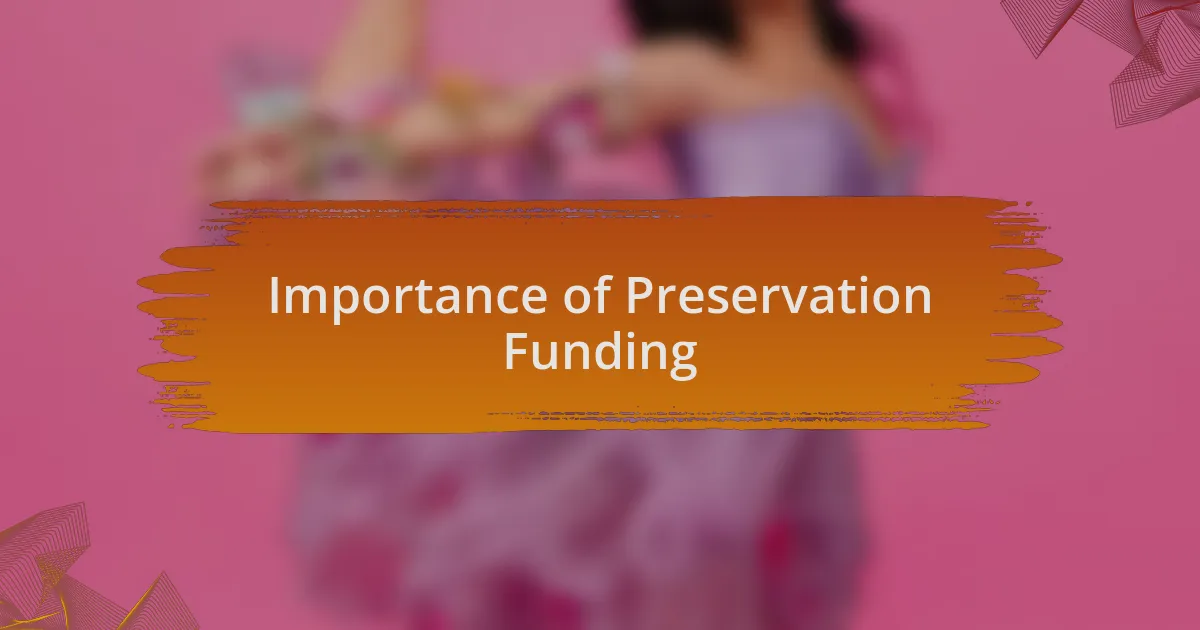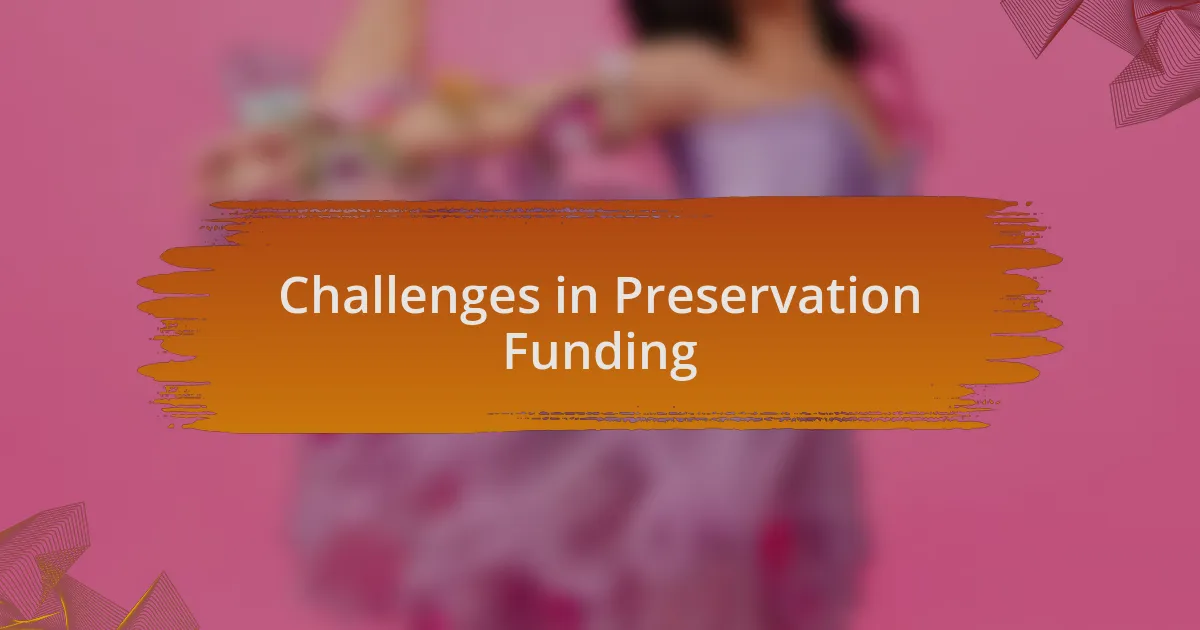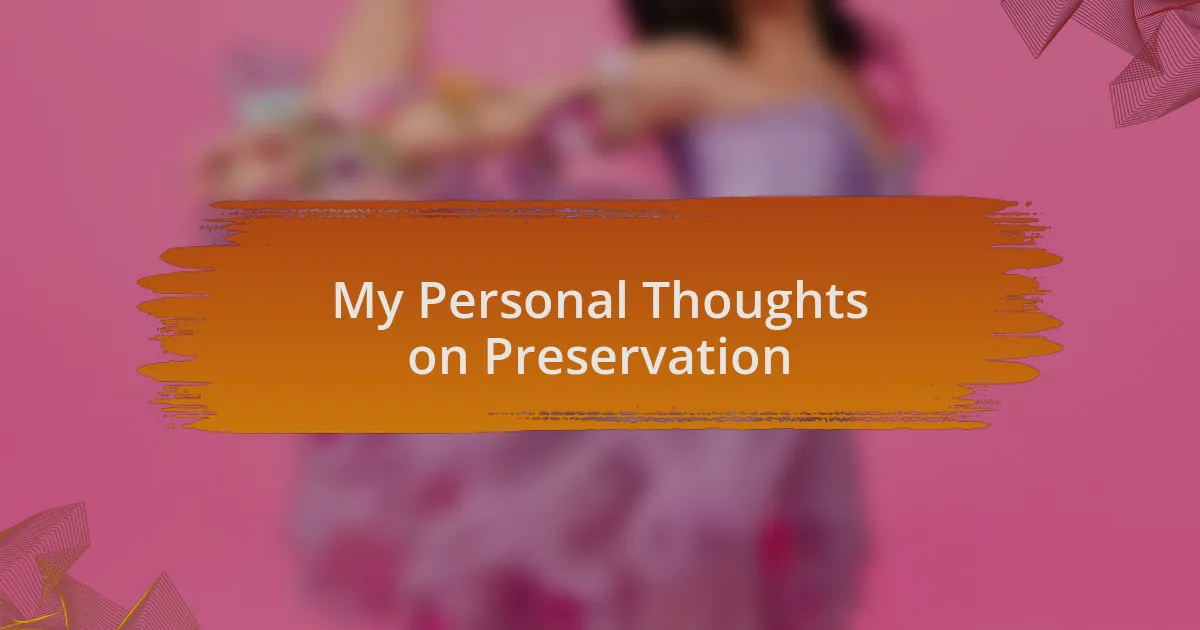Key takeaways:
- Cultural heritage tourism fosters deep connections between visitors and local communities by emphasizing immersion in customs and stories.
- Preservation funding is essential for maintaining cultural sites, supporting traditions, and revitalizing local economies through tourism.
- Investment in heritage strengthens community bonds and provides educational opportunities, transforming historic sites into learning experiences.
- Challenges like fluctuating political support and competition for resources necessitate sustainable funding strategies, such as diversifying revenue streams and leveraging technology.

Cultural Heritage Tourism Defined
Cultural heritage tourism is essentially about travel experiences that allow individuals to connect deeply with the historical and cultural fabric of a destination. Think about those moments when you stand in front of an ancient structure or a local festival; it’s not just the view that draws you in, but the stories and traditions woven into the very essence of that place. Have you ever felt a sense of belonging or nostalgia when visiting a site that echoes a culture not your own?
It goes beyond mere sightseeing; it’s about immersing oneself in the local customs, art, and narratives that define a community. I remember my visit to a small village in Italy where the locals proudly shared tales of their ancestors over a home-cooked meal. Those stories were as enriching as the stunning landscapes and architecture around me. This personal interaction added an invaluable layer to my understanding of their culture, making the experience much more than just a photo opportunity.
At its core, cultural heritage tourism serves as a bridge between visitors and communities, fostering appreciation for diverse traditions and lifestyles. It’s an invitation to explore what makes us uniquely human, provoking thought about our shared history. How often do we consider our role as visitors in sustaining these cultures? Engaging with cultural heritage encourages not only respect but also a commitment to preserving these treasures for future generations.

Importance of Preservation Funding
Preservation funding plays a crucial role in safeguarding our cultural heritage, ensuring these significant sites endure for future generations. I’ve seen firsthand how financial support can revitalize historic landmarks that might otherwise fall into disrepair. During my travels to a small town where funding helped restore its old theater, the revitalization breathed new life into the community, bringing locals together for performances that reignited their connection to their shared history.
Moreover, funding for preservation not only maintains physical sites but also supports the stories and traditions tied to them. I once attended a workshop funded by a heritage grant that featured local artisans demonstrating their crafts. It struck me how vital these funds are in fostering skills and practices that might otherwise be lost. When was the last time you engaged with a local tradition that made you appreciate the nuances of a culture? That experience profoundly impacted my understanding of the importance of financial support in cultivating cultural legacies.
This funding is more than just a monetary resource; it’s an investment in identity and legacy. We all have places that resonate with us, evoking memories and emotions that shape who we are. By allocating funds for preservation, we ensure that future visitors can feel the same connection I did standing in a centuries-old marketplace, surrounded by the vibrant sounds and scents of a living culture. Isn’t it essential to nurture these bonds that thread through time?

Benefits of Investing in Heritage
Investing in heritage fosters a sense of community and belonging. I recall visiting a historic district where a team of dedicated locals worked tirelessly to preserve their neighborhood’s character, transforming it into a vibrant hub for both residents and tourists. Witnessing this collective effort made me realize how crucial investment is—not just for restoring buildings, but for strengthening the bonds between people who share that space.
Furthermore, heritage investments can stimulate local economies in surprisingly profound ways. On my recent trip to a town that had transformed its historical sites into thriving tourist attractions, I was struck by how local businesses flourished along with the preservation efforts. It made me ponder: Can we afford to overlook the economic potential locked within our cultural resources? By funding heritage initiatives, communities not only safeguard their past but also unlock avenues for sustainable growth and employment.
Another significant benefit of investing in heritage is the educational opportunities it creates. I participated in a guided tour of a restored historical site where the rich narratives came alive, and I felt an immediate connection to the past. It dawned on me that these experiences not only inform visitors but also instill a sense of pride in locals. Isn’t it fascinating how storytelling can transcend time and spark interest in future generations? Ultimately, by prioritizing heritage funding, we can cultivate a deeper appreciation for our shared history and its relevance in today’s world.

Challenges in Preservation Funding
Securing consistent funding for preservation projects often feels like an uphill battle. I’ve seen firsthand how fundraising efforts can wane as enthusiasm fades over time. One community I observed had an initial surge of support for a historic school renovation, but as the months rolled on and costs began to rise, interest dwindled. What happens when passion fades? Do we risk losing not just buildings but the very stories they hold?
Another significant challenge in preservation funding is the competition for limited resources. Local governments frequently prioritize newer developments over historical sites, which can seem more economically viable. I remember attending a public meeting where community members passionately debated the merits of restoring an old theater versus investing in a new shopping center. It brought to light a difficult question: How do we value our past amidst the lure of modernity? It’s a delicate balance that requires ongoing advocacy and community engagement to keep preservation in the spotlight.
Moreover, fluctuating political climates can create uncertainty in funding allocations. One year, a passionate mayor championed heritage preservation; the next, priorities shifted with changing leadership. It leaves many projects in limbo. Can we rely on the continuity of support for our cherished cultural sites? The fleeting nature of these commitments highlights the need for strong community advocacy and creative funding strategies to ensure preservation initiatives can thrive despite these obstacles.

Strategies for Sustainable Funding
One effective strategy for sustainable funding is diversifying revenue streams. I’ve seen communities successfully combine grants, donations, and even user fees to create a balanced funding base for their cultural projects. When I attended a workshop on funding strategies, one speaker shared how they implemented small entry fees for guided tours at a historic site. Not only did this generate a steady income, but it also fostered greater appreciation and engagement from visitors.
Another approach that I’ve found to be impactful is cultivating partnerships with local businesses. For example, a historic village near where I live partnered with nearby restaurants to offer discounts and promotions for visitors. This not only helped fund preservation efforts but also created a vibrant ecosystem where cultural heritage and local economy complement each other. Isn’t it fascinating how collaboration can turn preservation into a community-wide effort?
Lastly, leveraging technology can open new avenues for funding. I recall a small nonprofit that launched a crowdfunding campaign for a heritage restoration project and engaged the community through social media storytelling. The project became a local talking point, igniting excitement and drawing in support from both near and far. How can we harness the power of technology to amplify our preservation efforts? Utilizing online platforms can mobilize a broader audience and create a lasting financial impact for cultural heritage projects.

My Personal Thoughts on Preservation
When I think about preservation, I can’t help but feel a deep sense of responsibility. I remember visiting a small town steeped in history; its charm came not just from the buildings but from the stories they held. That experience made me realize that preserving our cultural heritage is like safeguarding our collective memory. If we lose these sites, we lose a part of who we are.
I’ve also observed the passion that local activists bring to preservation efforts. I attended a community meeting where residents rallied to save a historic theater from demolition. Their heartfelt testimonies about the theater’s role in their lives were truly moving. It’s moments like these that emphasize the connection between heritage and identity. How can we not support such vital endeavors that resonate so deeply with people’s lives?
Moreover, I’ve often wondered about the role of future generations in preservation. When I see young people engaging with cultural heritage, whether through volunteering or advocacy, I feel hopeful. They remind me that preservation isn’t just about the past; it’s about ensuring these stories and spaces remain vibrant for the future. Aren’t we all responsible for passing down these treasures? They hold the key to understanding our history and shaping our future.